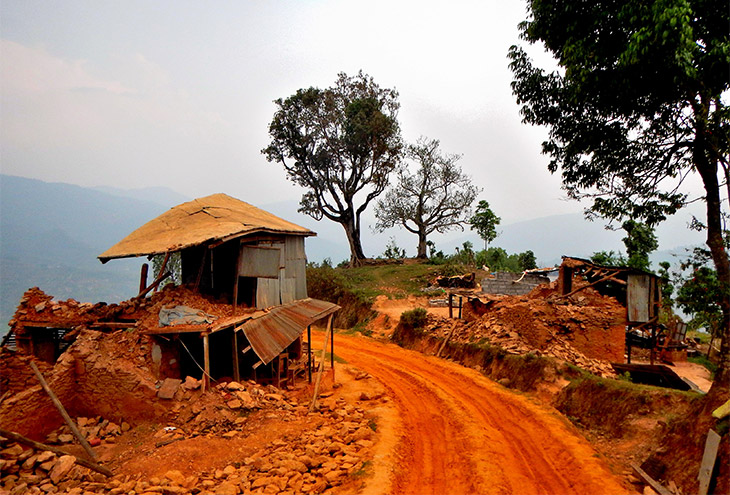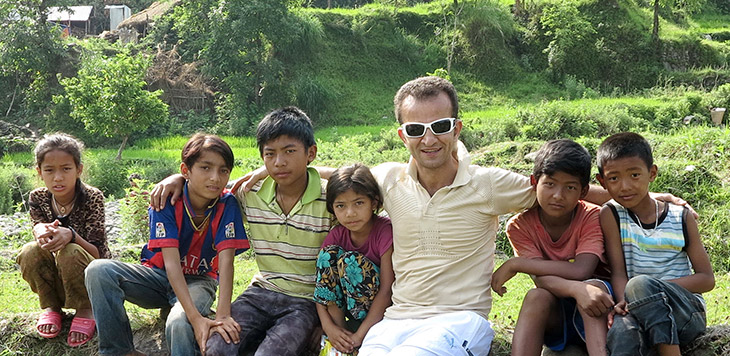Responding to remote areas in Nepal
Behrouz Moghadasi, Head of Search and Rescue in Iran, went to Nepal to assist as a member of the IFRC, before joining volunteer groups to provide further assistance. Here are his thoughts on, and photos of, the relief and response effort.
The Nepal earthquake killed more than 10,000 people and injured more than 30,000. It occurred at 11:56hrs on April 25, with a magnitude of 7.8 and a maximum Mercali intensity of IX. Continued aftershocks occurred with small intervals, a major shock occurred on May 12, with a magnitude 7.3.

Approximately nine million people were affected. Thousands of people were made homeless with cities damaged and entire villages flattened across many districts of country. Many century-old buildings were destroyed at world heritage sites.
Close to two million children had been driven out into the open, and were in desperate need of drinking water, psychological counselling, temporary shelters, sanitation and protection from disease.

The crisis was growing; after the primary event (the earthquake) people would have only a short time to plant crops before the onset of the Monsoon rains. Economic and social effects were.
After the earthquake occurred, within a few hours to a day, more than 80 per cent of the Nepalese Army and a number of volunteers were sent to the stricken areas. There were many problems that complicated the rescue efforts such as rainfall, aftershocks, landslides, Impassable roads, damaged communications infrastructure and further building collapses. International aid, foreign rescue teams and international agencies started to respond. As outlined by Arjun Katoch in CRJ 10:1, India was the first country to respond. International Agencies like UN, UNICEF, Red Cross and Doctors Without Borders also arrived in Nepal to assist.
The Nepalese Army was immediately mobilized after the earthquake to the 14 worst-affected districts and other severely damaged surrounding areas. Its troops directed action for Search and Rescue operations. But as the days passed by, the focus shifted to the distribution of relief materials. The army also provided security to transfer relief materials to the affected regions. It had many medical teams and first aid posts for to treat the injured and also got involved in the debris management of wrecked houses and structures.
The search, rescue and relief operation was been further intensified through number of support teams from over 40 various foreign countries.
The medical team of ministry of health and other friendly forces treated injured people in hospitals, field hospitals and medical outposts. The friendly forces also had their medical teams at various places. Reports indicated the medical teams from various countries treated more than 20,000 people.
Many foreign teams have established water points at various places to facilitate the displaced people with drinking water.
The Nepalese people responded to this crisis directly and indirectly. They are strong and wonderful. After the quake, they were the first people to arrive at the scene. They participated in all phases of response: search and rescue, relief, psychosocial support and donation. On the other hand, the involved people managed this crisis incredibly with patience, dignity, tolerance and tranquility. These particular characteristics and features of Nepalese people created a safe and suitable environment for rescuers and team-work. They co-operated very well and were friendly to rescuers. After two weeks, there were many villages and places without any teams for relief and rescue. During this period, the people themselves were responsible for all tasks, a significant communion exists between them.
Volunteers from around the world added details into online maps for crisis mapping to help plan emergency aid work. Information was mapped from data input, from social media, satellite pictures of impassable roads, collapsed houses, stranded, shelterless and starving people who needed help, and from messages and contact details of people willing to assist. On-site volunteers verified these mapping details wherever they could to reduce errors. First responders, the Red Cross, the Nepalese army and the United Nations used this data. Volunteers assumed a major role in this type of crisis mapping.
Immediately after the earthquake, volunteer groups formed and were effective. These groups included Nepalese or foreign people with different specialties and each divided into subgroups. Volunteers presented different tasks including search and rescue, need assessment, data collection, relief works, first aid, health, shelter, medical care, food distribution, water and sanitation, displacement of people, psychosocial support, children protection, etc.
In many places these volunteers were the first team on the field. Especially in impassable places, where access routes had been closed.

I worked with three groups of volunteers: Himalayan Crossroads, Yellow House and Medical Trek Nepal.
In my opinion, a strong point of the crisis was the good behavior and amazing performance of the Nepalese people, while poor relations between government and the people was a weak point.

Behrouz Moghadassi, who is a physician, is Head of Iran Search and Rescue, which he was instrumental in establishing. He is a Wilderness Search and Rescue trainer at the Red Crescent University, and a Senior Relief and Rescue Officer at the IFRC. In the past, he has worked for UNICEF to care and protect children in emergencies, and was in charge of the Emergency Ward at Bu Ali Hospital, Ardebil University of Medical Science. Read Emily Hough's interview with him in CRJ 10:1
Behrouz Moghadasi, 30/06/2015